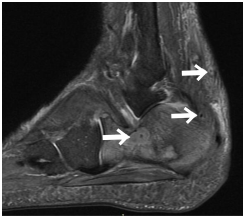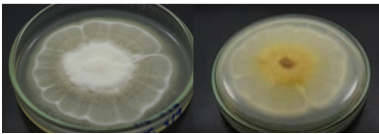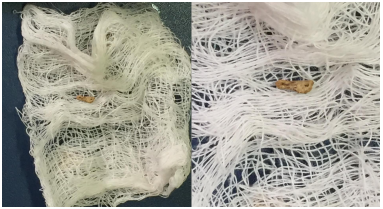Introduction
Mycetoma is a chronic and slow developing granulomatous disease characterized by large painless tumour-like subcutaneous swellings, formation of sinuses, and discharge that usually contains grains. Although it may occur in various countries, it is endemic in Sudan, Mexico, and India, and frequent in Brazil and Argentina1. It can be caused by either fungi or bacteria. The feet and legs are the most commonly affected regions, but any body part can be affected1,2. We report the case of a 59-year-old male patient with mycetoma caused by Phellinus spp., a basidiomycete genus. The diagnosis was confirmed with clinical examination, magnetic resonance imaging (MRI), soft tissue and bone biopsy, culture, and polymerase chain reaction. There have been case reports of chronic granulomatous disease (CGD) complicated with subcutaneous abscess due to Phellinus spp. (3,4 Fungal infections related to Phellinus spp. are an emerging disease in CGD patients, but this remains a rare condition in patients without CGD5. To the best of our knowledge, this is the first reported case of mycetoma due to Phellinus spp. without CGD.
Case report
Our patient presented with a 3-year history of foot swelling and progressive increase in size. He also complained about episodes of pain and the emergence of yellow discharges containing grains. He had previous history of pre-diabetes. Subsequently, the patient reported a wound caused by a piece of wood in childhood. Physical examination revealed a diffuse firm swelling mainly on the lateral aspect of the right foot, and three discharging sinuses (Figure 1).Admission tests revealed discrete anaemia (haemoglobin 12.6 g/dL). Erythrocyte sedimentation rate (70 mm) and C-reactive protein (5.4 mg/L) levels exceeded the normal range.
MRI of the right foot showed overgrowth of soft tissues, bone oedema, and small rounded hyperintensity surrounded by a low-signal-intensity rim with a hypointense dot in the centre, called a dot-in-circle sign (Figure 2). Diagnosis of mycetoma was made and a soft tissue and bone biopsy cultures were performed to identify the etiologic agent. The culture revealed a mycelial colony with bright white and yellow with abundant aerial mycelium on potato dextrose agar (Figure 3). Polymerase chain reaction was performed by sequencing the ITS region, using the panfungal primers ITS1 and ITS4. After obtaining the sequences, the NCBI Blast tool was used and indicated Phellinus spp. Therapy was started with voriconazole (6 mg/kg every 12 hours for 2 days followed by a maintenance regimen of 4 mg/kg every 12 hours for 7 days) and amphotericin B lipid-complex (5 mg/kg/day for 4 weeks followed by a maintenance regimen of 5 mg/kg/week for 6 months). After 30 days, he exhibited clinical improvement and the piece wood spontaneous came out (Figure 4). Six months later, the patient remains asymptomatic.
Discussion
To our knowledge, there is no prior data about Phellinus spp. infection with isolated mycetoma in the medical literature. Information regarding treatment is also scarce, but it is believed that lipid formulations of amphotericin B and azoles (such as voriconazole) may be helpful, especially in severe disease. According to current literature, amphotericin B-based regimens may be a better alternative, but voriconazole has also been successfully used to treat Phellinus spp. infections5. Additionally, identification of pathogen species is difficult because many isolates fail to sporulate and remain sterile in routine mycology media5.
In Brazil, mycetoma cases range between 101 and 500 per year1. MRI is useful for clinical diagnosis of fungal infection, since it allows evaluation of the invasion and extent of the lesion in most cases. The dot-in-circle sign is indicative of the presence of fungal grains, but not suggestive of the species. Small lesions present better prognosis. Long-term treatments are common, and sometimes ineffective1. Although surgical treatment may be necessary in many cases, it was not necessary in our patient.
We present a rare etiological agent for mycetoma. CGD should be investigated in any patient with identified Phellinus spp. infection, although X-linked mutations cannot be evaluated in many health centres. More sudies are needed to better understand the management and prognosis of infections caused by Phellinus spp.


















